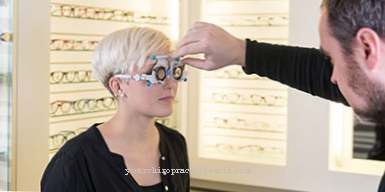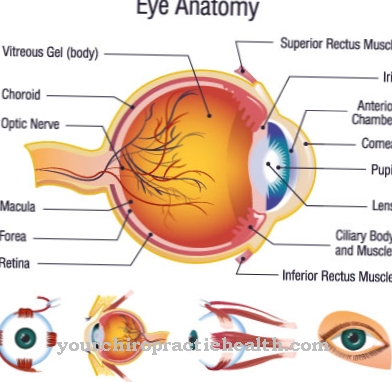If the type or extent of ametropia between the right and left eye is considered to be Anisometropy (Inequality) designated. This is the case if there is a difference of at least 2.00 diopters.
What is anisometropy?

© coldwaterman - stock.adobe.com
In anisometropy, the left and right eyes differ significantly in terms of the type or extent of the optical ametropia. A wide variety of differences are possible. For example, one eye can be nearsighted and the other farsighted. Another possibility is that one eye is only very slightly farsighted and the other very strong.
If a large anisometropy manifests itself in childhood, this can lead to functional impaired vision of the eye, which is more ametropic. During this phase, which is very important for development, the eye is severely neglected by the brain so that it does not learn to see correctly. This cannot be reversed even by making a later correction. Therefore, anisometropia in childhood should definitely be treated.
causes
There are numerous possible causes for the anisometropy. The focus of the light rays that fall on the eye is not on the retina, which is necessary for the transmission of sharp image signals to the brain. In myopia, the focal point is in front of the retina, as the eye is either too long or the refractive power of the eye lens is too high.
In the case of farsightedness, the opposite is true: here the eye is either too short or the refractive power of the lens is insufficient. In both cases, the focus is behind the retina. The ametropia often occurs in childhood and then persists for a lifetime. Other visual defects, on the other hand, develop with age.
The causes of the so-called refractive anisometropy are differences in the refractive index of the cornea and lens. The length anisometropy results from the fact that the eyeballs are of different lengths. The absence of an eye lens is a special case of anisiometropy. This could be due to an injury or removal of the lens.
You can find your medication here
➔ Medicines for visual disturbances and eye complaintsSymptoms, ailments & signs
Anisometropy shows that the spectacle values of both eyes are more than two diopters different. The affected person can be both nearsighted and farsighted at the same time. This is an enormous burden for the brain, as the optic nerve constantly transports sharp, but also fuzzy images into the brain at the same time.
Objects close to the eye are shown in focus by the nearsighted eye and blurred by the far-sighted eye. With objects that are in the distance, the opposite is true. In a healthy person, two relatively identical images arrive in the brain. If there is anisometropy, the images are very different.
In this case, the sharp representations must be identified and the less good ones masked out. Those who suffer from severe anisometropia often also complain of tired eyes and headaches.
Diagnosis & course
The eye doctor or optician can determine the exact extent of the anisometropy by measuring the visual acuity. A refractometer is usually used for this. This device provides the sphere value (given in diopters) and other information as to whether there is any astigmatism.
The visual aid is adjusted based on the collected values. The visual acuity is determined separately for both eyes. Ultimately, both visual defects need to be corrected. This makes it possible to use convex lenses in one part and concave lenses in the other. Almost everyone has minor deviations between the right and left eye.
If left untreated, anisometropy often leads to strabismus in infancy. The reason for this is that the weaker eye is "switched off" by the brain, so to speak. Anisometry should therefore be treated before puberty sets in, as it can no longer be successfully treated at a later point in time.
When should you go to the doctor?
Anyone who regularly suffers from tired eyes, headaches or a feeling of pressure around the eyes should seek medical advice. The doctor can determine whether it is anisometropia and, if necessary, consult an ophthalmologist or optician. Anisometropia must always be diagnosed and treated in order to avoid long-term impairment of vision. If the visual disorder remains untreated, it can also lead to decreased well-being, chronic headaches and other complaints.
Wearers of glasses and contact lenses should speak to an ophthalmologist if they have migraine attacks or have increasingly poor eyesight. As the anisometropia can worsen with age, the eyesight of both eyes should be checked regularly. In severe cases, the diopter strength must be adjusted annually or more often to ensure optimal vision. Therefore: even with a diagnosed anisometropia you have to go to the ophthalmologist or optician regularly. Should complaints nevertheless arise, further examinations are recommended. There may be another eye condition that needs treatment.
Doctors & therapists in your area
Treatment & Therapy
If glasses are used in the case of anisometropy, there are some disadvantages: The correction results in retinal images of different sizes that are poorly or not processed by the brain. The eyes also look very different behind the lenses and there is also a one-sided pressure load.
There are restrictions in terms of comfort and aesthetic effect. The optician generally has limits, so that three diopters are the maximum difference between the right and left lens. If the ametropia deviates more strongly, perception disorders are possible. Contact lenses are more suitable for correcting a large anisometropia.
Surgical interventions are also available, but surgical correction of the eyes in children is controversial. In adulthood, anisometropia can also be performed with laser eyes after adequate contact lens simulation.
Outlook & forecast
The anisometropy has no good prospect of improvement without ophthalmological therapy. Instead, an increase in complaints can be expected in the coming months and years.
Without corrective measures, the information from the weaker eye will not be sufficiently processed in the brain. Therefore, the nerve cord visibly atrophies. Strabismus sets in in these patients and, in the long term, there is a further increase in visual impairment. A complete cure of the anisometropy is not always given even with early treatment with the current medical possibilities. It depends on the existing visual acuity.
However, there are clear improvements in a good treatment plan that must be drawn up and adhered to over many years. The visual acuity of the weaker eye can be trained more strongly by various methods, so that an increase in vision develops in this eye. The vision of both eyes is adjusted to each other in slow steps.
Although the development of the eye has already ended at the age of 12, necessary treatments and therapeutic measures must be taken in adulthood in the case of anisometropia. There is a very high risk of relapse which must be counteracted. Because of the potential for relapses, the patient rarely goes out of treatment as completely cured.
You can find your medication here
➔ Medicines for visual disturbances and eye complaintsprevention
The best way to avoid anisometropy is to actively do something yourself to maintain normal vision and to prevent poor eyesight. It can help to pay attention to the reading distance (not less than 30 centimeters), as too short a reading distance promotes myopia. If you work a lot on your computer, you should choose a large monitor and place it a meter away from you.
During the sewing work it is advisable to look into the distance from time to time. In addition, good lighting should be ensured. A little eye training does not change the anatomical conditions of the eyes, i.e. the optics, but the contrast sensitivity is increased. Even small activities such as wearing and removing the visual aid help to do this.
Aftercare
Treatment of anisometropia usually does not result in a final cure. Adults in particular often relapse after successful therapy at a young age. As a result, permanent vision correction is necessary, but this is only treated by a doctor in the event of acute complaints.
A refractometer is used to determine visual acuity. The patient can choose between the visual aids for smaller dioptre differences between the right and left eye. Contact lenses should be used if there are large deviations. It is scientifically recognized that processing the images is comparatively strenuous for the brain.
However, the perceptions of everyday life hardly present any difficulties, so that the eyesight is decent. Some patients choose to have surgery that can treat anisometropia as well. Adults can strengthen their eyesight through small practice sessions.
These can be easily carried out at work or in private life. A reading distance of at least 30 centimeters must be observed. When working on a screen, you should prefer large displays and not stare continuously at the monitor. A look into the distance increases the contrast sensitivity.
You can do that yourself
Everyday life with anisometropy without appropriate correction is difficult to master. Often the brain switches off one eye, the other remains untrained. Those affected cannot do anything themselves to treat themselves, except to put themselves in the hands of an ophthalmologist.
In most cases, the ametropia is corrected with contact lenses. Correction with glasses can lead to retinal images (aniseikonia) in different sizes. These can only be accepted inadequately or not at all by the brain. Further difficulties would arise due to the optical impression and the weight of the different lenses.
Correction using contact lenses is therefore the method of choice. This also makes everyday life easier, because the contact lenses lie directly on the eye and "send" the images perceived to the brain in a processable impression. This can now combine the two-sided impressions into a whole. Then a different ametropia is no longer a problem. However, the visual impairment should be checked at regular intervals by the ophthalmologist so that he can adjust the necessary lens strengths.
Training is required even after fitting with contact lenses. After all, the brain first has to get used to receiving "normal" impressions. Then it is important to persevere.




.jpg)









.jpg)













